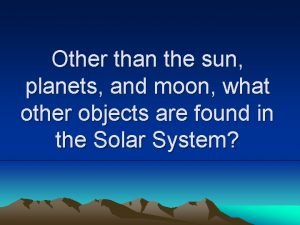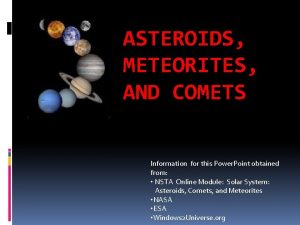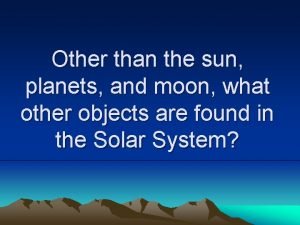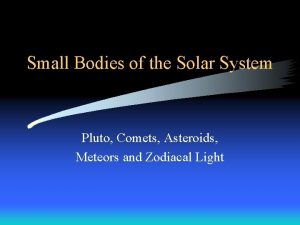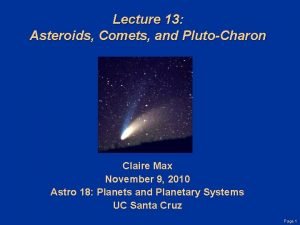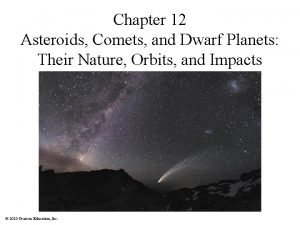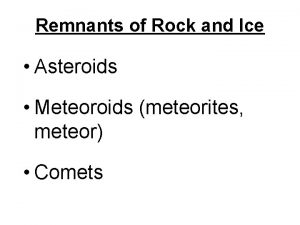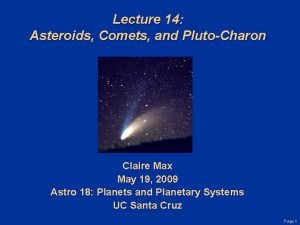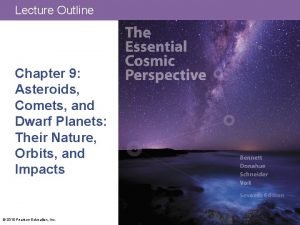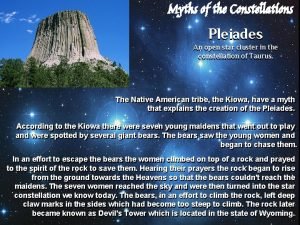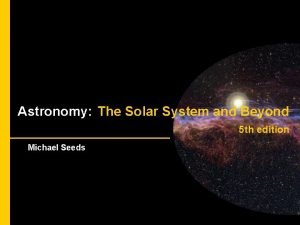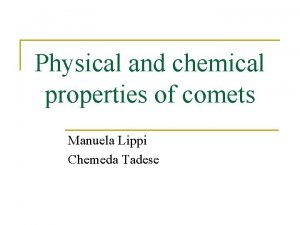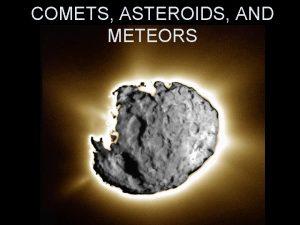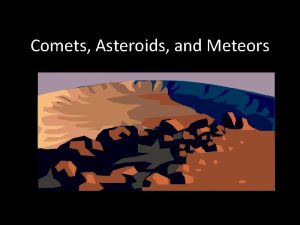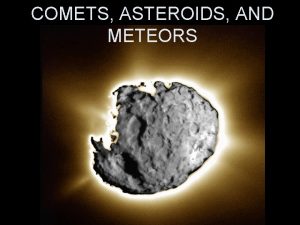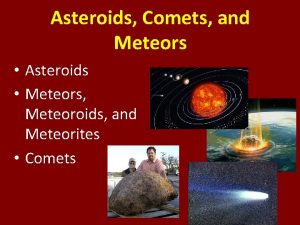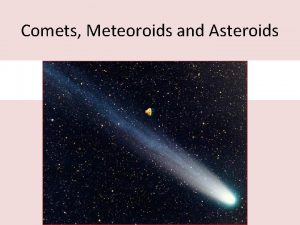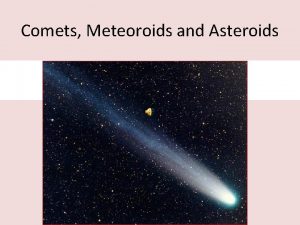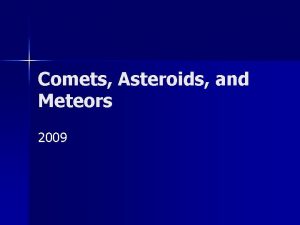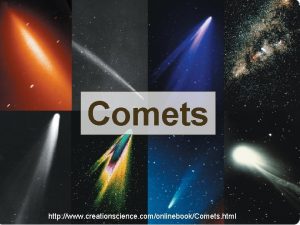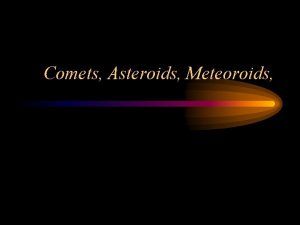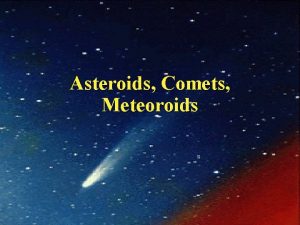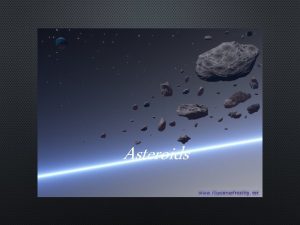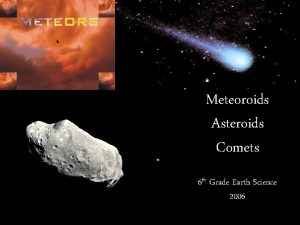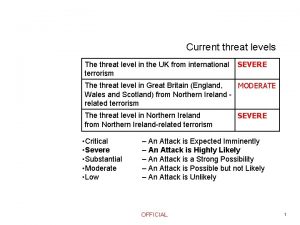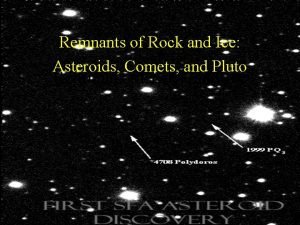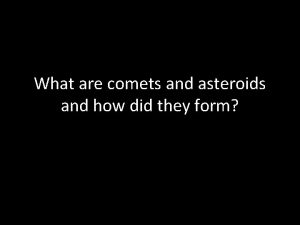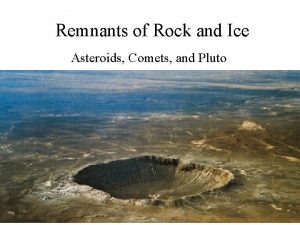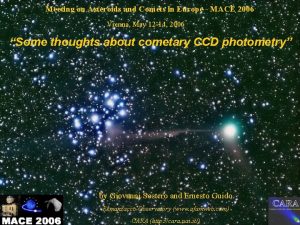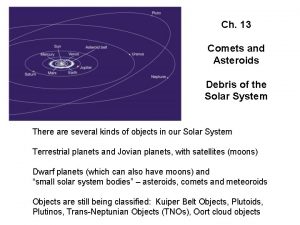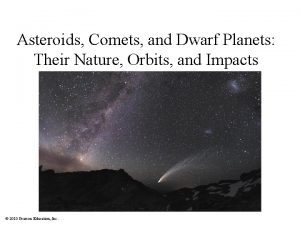The Threat to Earth from Asteroids and Comets





























- Slides: 29

The Threat to Earth from Asteroids and Comets… and Possible Countermeasures Clark R. Chapman Southwest Research Inst. Boulder, Colorado “Managing Global Scale Disasters” Western Psychological Association Irvine, California 12 April 2002

The Hazard from Asteroids and Comets n Each year, there is a 1 -in-200, 000 chance that an asteroid or comet more than one kilometer wide will strike the Earth. n 40 percent of these objects remain to be found, and could strike without warning, threatening the future of civilization. n This extreme example of a natural disaster (a tiny chance of happening, but with huge consequences) challenges a rational response by citizens and policy-makers.

The processes that formed the planets 4. 6 billion years ago left smaller comets and asteroids… some of which occasionally cross the Earth’s orbit and can strike our planet if it happens to be there at the same time.

Small impacts happen frequently

Larger impacts happen rarely in human history. . . This Siberian forest (the size of a major city) was felled in 1908 by a 15 -Megaton asteroid explosion

Still larger, globally destructive impacts happen very rarely. . . n Comet Shoemaker- Levy 9 struck the planet Jupiter in 1994, blackening parts of its atmosphere larger than the whole planet Earth n But Earth is struck Image from Peter Mc. Gregor and Mark Allen, ANU 2. 3 m telescope. by devastating objects less often… every million years

HUGE impacts have happened before… 65 million years ago

Very Poorly Somewhat Very Well WE KNOW THIS… What Do We Know About the Impact Hazard? n How many asteroids and comets there are of various sizes in Earth-approaching orbits (hence, impact frequencies are known). n How much energy is delivered by impact (such as the TNT equivalence, size of resulting crater). n How much dust is raised into the stratosphere and other environmental consequences. n Biosphere response (agriculture, forests, human beings, ocean life) to environmental shock. n Response of human psychology, sociology, political systems, and economies to such a catastrophe. That’s where YOU come in!

Classification of Hazards ade c e D n High Altitude Disintegration (Brilliant Flash of Light) n Projectile fragments and disperses at high altitudes (over 40 km) n Negligible surface damage n Local/Regional Effects (Blast Damage, Tsunami) ium n n lle Mi n Projectile explodes in lower atmosphere or craters surface n Severe localized damage from blast or flooding by tsunami n Global Damage (Environmental Disaster) s ear Y n lio Mil n Short-term global-scale climatic changes (e. g. impact winter) n Global loss of food crops leads to large-scale famine, disease, and possible breakdown of civilization n Mass Extinction (Environmental Holocaust) ed r d s Hun Year lion l i M n Severe global environmental destruction (e. g. K/T event) n Many species lost forever; all, or nearly all, human beings die

Chief Environmental Consequences of Impacts

Is Civilization Robust or Fragile? A State of Mind…? n Arguments for Fragility Modern people are disconnected from nature, survivability n Technology is ever more specialized n People are interdependent on distant resources, other nations n If societal breakdown spawns violence, modern weaponry is very dangerous n n Arguments for Robustness Technological refugia exist (such as bomb shelters) n Society has become experienced in disaster recovery n Technological know-how has become pervasive n Historical precedence; recovery from WWII was rapid n

Risk vs. Scale of Impact n Annual fatalities m i na spheri Strato zone illustrates our range of uncertainties for agricultural disaster due to stratospheric dust Ts u n Orange/yellow c Dust peak for events near the “threshold size”, about 2 km

A Royal Flush Odds: 1 to 649, 739 u It is more likely that a mile-wide asteroid will strike Earth next year than that the next poker hand you are dealt will be a royal flush.

20 th Century Catastrophes: We have much more to worry about! Source: John Pike n Averaged over long durations, the death rate expected from impacts is similar to that from volcanoes.

Chances from Dying from Selected Causes (for U. S. A. ) By terrorism (year 2001) By terrorism (since 1970)

Fatality Rates Compared with Accidents and Natural Hazards

Mitigation Options n Spaceguard Survey (ongoing telescopic search) n 90% of hazardous NEAs may be found by 2010, certified as safe. n Very unlikely: one is found that will strike Earth within decades. n Deflect Asteroid away from Earth (nudge it from threatening path) n Spacecraft technologies exist to deliver deflection devices to threatening asteroid, given years/decades warning and lead-time. n Low-thrust device options: rocket engine, solar sail, mass driver, even “paint-it-black” to take advantage of Yarkovsky Effect n Powerful devices: anchored bombs or stand-off neutron bomb n Standard Hazard Mitigation (THIS IS FOR YOU TO FIGURE OUT!) n Extrapolate civil defense/natural disaster management from local to world context (e. g. store food supplies, evacuate countries around ground zero, prepare for post-disaster crisis).

Headline: “Mile-Wide Asteroid Will Hit in 2028” Which is least likely to be correct? A. The news report is wrong due to bad or hyped journalism. B. The scientific forecaster goofed. We’re safe. C. is tiny; The astronomers erred. The asteroid most of the world is safe. D. An asteroid will hit Earth in 2028. The correct answer is “D”:

The “Scary” Case of 1997 XF 11 n In March 1998, head- lines warned of possible impact in 2028. 10 n The next day, old data 5 (100000 km) ruled it out…but the prediction was badly mistaken. 0 -5 -10 -15 -10 -5 0 5 (100000 km) 10 15

Prediction is the Event n Scientists who predict think of predictions as dry scientific results, with objective error-bars. n Users of such predictions are mobilized into action by the prediction. n The predicted event may not happen as predicted; it may or may not have consequences. The predictions always have consequences. n Predictions of emotionally laden disasters result in subjective, sometimes irrational responses. n Predictions must be made with social responsibility, whether of a potential terrorist operation or of an asteroid impact. Astronomers are learning!

The Torino Scale Events Having No Likely Consequences Events Meriting Careful Monitoring Events Meriting Concern Threatening Events Certain Collisions

How the Torino Scale is Calculated: From the Probability of Impact and Size

Current Dilemma. (Work is Starting to Fix it)

Our Sw. RI “White Paper”: Highlights Lack of Planning

Findings: Evaluation, Warning, and Mitigation n Existing structure is disorganized: Astronomers are just starting to learn how to communicate, but relevant agencies (e. g. FEMA) aren’t prepared to listen and act. n Asteroid deflection scenarios have been conceived, but no serious systems engineering or planning has been done to deal with various possible cases. n There is no known consideration by civil defense and disaster management agencies, let alone any assignment of responsibilities to relevant agencies. n No US governmental scientific advisory body has formally established the priority that the impact hazard should command with respect to other national priorities.

There Are Some Hopeful Signs n The British government debated the impact hazard and has started (a bit) to do something n The Organization for Economic Cooperation and Development (OECD) Global Science Forum decided in January 2002 to make NEO’s one of its top priority projects through 2003 n SAIC and the US Air Force Space Command are investigating how to establish a “Natural Impact Warning Center” n Public interest remains high, even if there is very little governmental funding

Some Salient Facts about the Impact Hazard n It is not a “Deep Impact” or “Armageddon” shoot-emnot down just before they hit scenario (sorry, Benny!) n For asteroids, orbiting in the inner solar system, it is a case of finding them decades in advance of an impact…with long lead-times for mitigation: For every asteroid with <1 year warning time, there are 50 with 5 decades of lead-time (but comets are another matter) n It is one of the few big hazards for which it is technologically feasible, with some confidence, to stop the catastrophe from happening (by deflection) n Near-miss scares and cries of “Wolf!” are much more likely than an actual catastrophic impact

Why are the big/rare ones so much more important than Tunguskas? n Only asteroids larger than ~1 mile across can be globally destructive and threaten civilization n For every devastating 15 -MT Tunguska blast, there are ~100 earthquakes, floods, and typhoons that are equally destructive n Cost-effectiveness drops sharply with size: the average annual fatalities drop while the costs of finding the objects and responding to them rises But, there are contrary viewpoints and interests: On a politician’s “watch”, why would he/she care about what might happen decades from now? And there are “Star Warriors” in the Do. D who would like to test their inventions and try shooting down small asteroids. And astronomers who would love to have more and bigger telescopes.

Conclusions…and Transition to the Psychological and Sociological Perspectives n The impact hazard is REAL but it is VERY UNLIKELY to happen during our lifetimes n Its potential consequences are horrific… exceeding any other natural hazard and equalling all-out nuclear war n We could avert a threatened impact n In a post-September 11 th world, it is difficult (for me) to predict how people might react to nearmisses, huge-but-low-probability disasters, bombs in space, and other impact hazard issues
 What is the difference between meteors and comets
What is the difference between meteors and comets Difference between comets and asteroids and meteors
Difference between comets and asteroids and meteors Asteroids meteors and comets worksheet
Asteroids meteors and comets worksheet Comets asteroids
Comets asteroids Comets asteroids
Comets asteroids Origin of asteroids
Origin of asteroids Asteroids
Asteroids A rocky leftover planetesimal orbiting the sun is
A rocky leftover planetesimal orbiting the sun is Jupiter nudges the asteroids through the influence of
Jupiter nudges the asteroids through the influence of Myths about comets
Myths about comets Properties of comets
Properties of comets Physical properties of comets
Physical properties of comets Hình ảnh bộ gõ cơ thể búng tay
Hình ảnh bộ gõ cơ thể búng tay Frameset trong html5
Frameset trong html5 Bổ thể
Bổ thể Tỉ lệ cơ thể trẻ em
Tỉ lệ cơ thể trẻ em Voi kéo gỗ như thế nào
Voi kéo gỗ như thế nào Tư thế worm breton
Tư thế worm breton Hát lên người ơi
Hát lên người ơi Các môn thể thao bắt đầu bằng tiếng chạy
Các môn thể thao bắt đầu bằng tiếng chạy Thế nào là hệ số cao nhất
Thế nào là hệ số cao nhất Các châu lục và đại dương trên thế giới
Các châu lục và đại dương trên thế giới Công thức tính độ biến thiên đông lượng
Công thức tính độ biến thiên đông lượng Trời xanh đây là của chúng ta thể thơ
Trời xanh đây là của chúng ta thể thơ Mật thư anh em như thể tay chân
Mật thư anh em như thể tay chân Làm thế nào để 102-1=99
Làm thế nào để 102-1=99 Phản ứng thế ankan
Phản ứng thế ankan Các châu lục và đại dương trên thế giới
Các châu lục và đại dương trên thế giới Thể thơ truyền thống
Thể thơ truyền thống Quá trình desamine hóa có thể tạo ra
Quá trình desamine hóa có thể tạo ra
